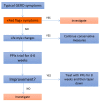Gastro-Esophageal Reflux in Children
- PMID: 28763023
- PMCID: PMC5578061
- DOI: 10.3390/ijms18081671
Gastro-Esophageal Reflux in Children
Abstract
Gastro-esophageal reflux (GER) is common in infants and children and has a varied clinical presentation: from infants with innocent regurgitation to infants and children with severe esophageal and extra-esophageal complications that define pathological gastro-esophageal reflux disease (GERD). Although the pathophysiology is similar to that of adults, symptoms of GERD in infants and children are often distinct from classic ones such as heartburn. The passage of gastric contents into the esophagus is a normal phenomenon occurring many times a day both in adults and children, but, in infants, several factors contribute to exacerbate this phenomenon, including a liquid milk-based diet, recumbent position and both structural and functional immaturity of the gastro-esophageal junction. This article focuses on the presentation, diagnosis and treatment of GERD that occurs in infants and children, based on available and current guidelines.
Keywords: children; extraintestinal symptoms; gastro-esophageal reflux; guidelines; infants.
Conflict of interest statement
The authors declare no conflict of interest.
Figures


References
Publication types
MeSH terms
LinkOut - more resources
Full Text Sources
Other Literature Sources
Medical

